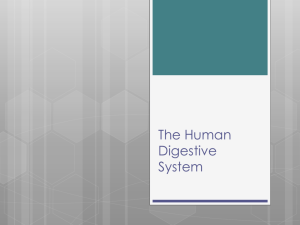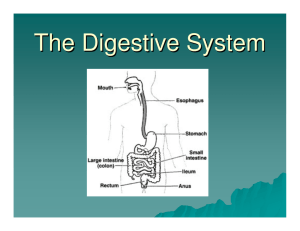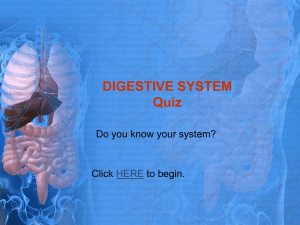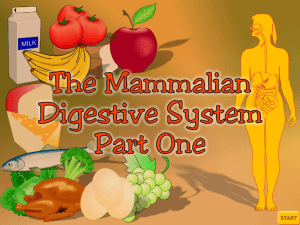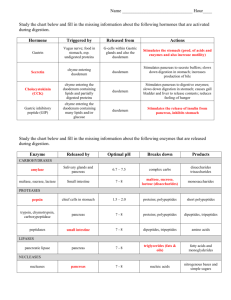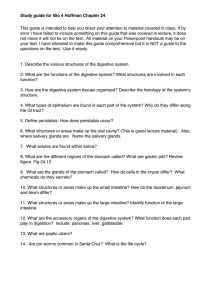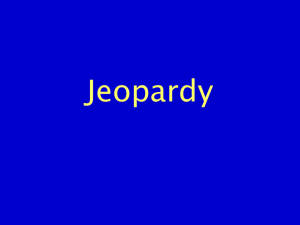Digestive System Outline I. Gastrointestinal tract
advertisement
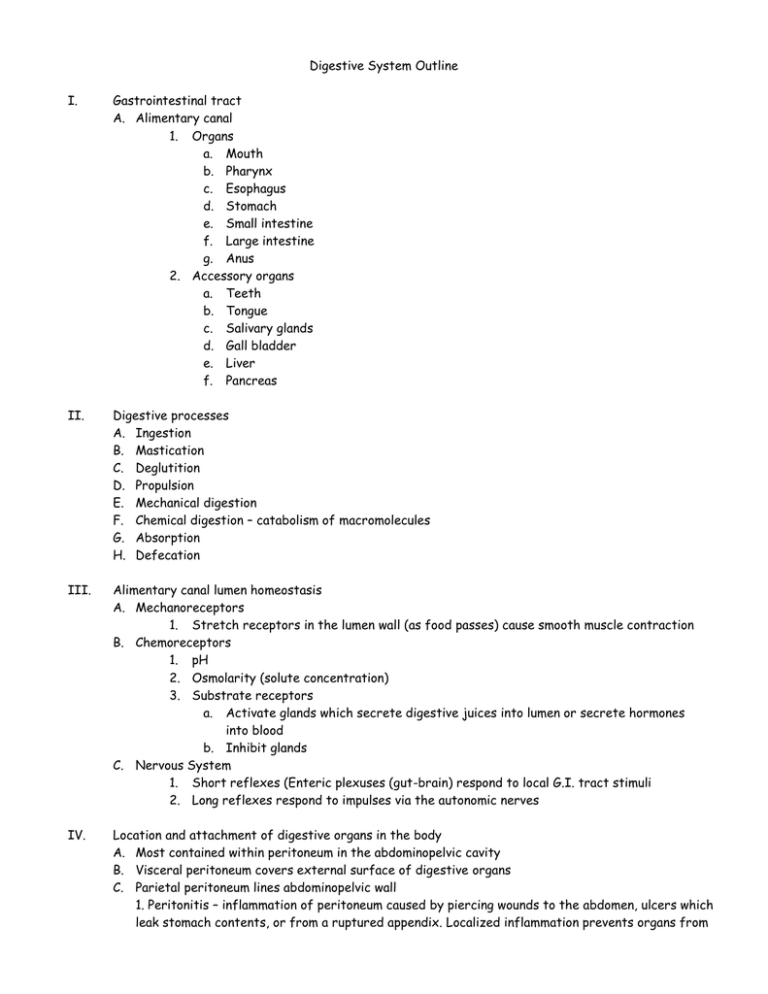
Digestive System Outline I. Gastrointestinal tract A. Alimentary canal 1. Organs a. Mouth b. Pharynx c. Esophagus d. Stomach e. Small intestine f. Large intestine g. Anus 2. Accessory organs a. Teeth b. Tongue c. Salivary glands d. Gall bladder e. Liver f. Pancreas II. Digestive processes A. Ingestion B. Mastication C. Deglutition D. Propulsion E. Mechanical digestion F. Chemical digestion – catabolism of macromolecules G. Absorption H. Defecation III. Alimentary canal lumen homeostasis A. Mechanoreceptors 1. Stretch receptors in the lumen wall (as food passes) cause smooth muscle contraction B. Chemoreceptors 1. pH 2. Osmolarity (solute concentration) 3. Substrate receptors a. Activate glands which secrete digestive juices into lumen or secrete hormones into blood b. Inhibit glands C. Nervous System 1. Short reflexes (Enteric plexuses (gut-brain) respond to local G.I. tract stimuli 2. Long reflexes respond to impulses via the autonomic nerves IV. Location and attachment of digestive organs in the body A. Most contained within peritoneum in the abdominopelvic cavity B. Visceral peritoneum covers external surface of digestive organs C. Parietal peritoneum lines abdominopelvic wall 1. Peritonitis – inflammation of peritoneum caused by piercing wounds to the abdomen, ulcers which leak stomach contents, or from a ruptured appendix. Localized inflammation prevents organs from sliding past one another and sharp excruciating abdominal pain results as the visceral and parietal peritoneum stick to one another D. Mesentery is a double peritoneum which suspends digestive organs to abdominopelvic walls V. Splanchnic circulation = 25% cardiac output A. Branch from abdominal aorta B. Digestive arteries 1. Hepatic artery a. Stomach b. Duodenum c. Pancreas d. Liver 2. Splenic artery a. Pancreas b. Stomach c. Spleen 3. Celiac trunk a. Left gastric branches 1. Spleen 2. Liver 3. Stomach 4. Mesenteric arteries a. Small intestine b. Large intestine C. Hepatic portal circulation – circulates venous blood from the small intestine to the liver VI. Alimentary canal histology A. Four layers 1. Mucosa (mucous membrane) innermost layer a. Functions 1. Secretion of mucus (goblet cells) 2. Secretion of digestive enzymes 3. Secretion of hormones 4. Absorption of molecules into the blood b. Simple columnar epithelium 2. Submucosa a. external to mucosa b. Rich in nerve fibers and blood vessels c. Dense connective tissue 3. Muscularis externa a. Peristalsis b. Contain circular and longitudinal smooth muscle (Circular muscles thicken to form sphincters) 4. Serosa a. Protective outermost layer b. Forms visceral peritoneum c. Consists of areolar connective tissue and simple squamous epithelium d. Serosa replaced with adventitia in the esophagus which consists of fibrous connective tissue VII. Functional anatomy of the digestive system A. Mouth (oral or buccal cavity) 1. Stratified squamous epithelium 2. Defensins are antimicrobial peptides produced by the mucosa 3. Lips (labia) and cheeks keep food between the teeth during mastication; labia connected to gums by labial frenulum 4. Palate forms the roof of the mouth a. hard palate – anterior in mouth; used to push food with tongue before swallowing b. Soft palate – posterior in mouth; raised reflexively to close off Nasopharynx during swallowing (Try to breathe and swallow at the same time to initiate this reflex) c. Uvula – projects downward from the soft palate to initiate gag reflex if food is too large for deglutition 5. Tongue a. Mixes food with saliva to form food bolus b. Composed of skeletal muscle c. Lingual frenulum anchors tongue to the floor of the mouth (ankyloglossia – tonguetied speech is corrected by cutting the lingual frenulum) d. Papillae 1. Filiform papillae – give tongue rough surface for licking food 2. Fungiform papillae – give tongue red hue due to vascular core 6. Salivary glands a. Saliva – produced by serous cells 1. Cleanses mouth 2. Dissolves food chemicals for taste 3. Moistens food to form bolus 4. 97-99.5% water 5. pH (6.75 – 7.00) 6. 1 000 – 1 500 mL per day 7. Parasympathetic nervous control (Autonomic) a. chemoreceptors initiate saliva production via the facial & glossopharyngeal nerves b. bacterial toxins in the lower GI tract, spicy foods, and hyperacidity (precursor of nausea) will also initiate saliva production 8. Sympathetic nervous control results in a thick mucin rich saliva and dry mouth (halitosis can result due to decomposing food molecules) 9. Contains amylase to begin catabolism of starch 10. Nitric oxide (bactericidal agent) 11. Immunoglobulin A (IGA) defends against bacterial infection 12. Lysozymes bactericidal, preventing tooth decay 13. Glycoprotein mucin forms a thick mucus which lubricates oral cavity 14. Electrolytes (Sodium, potassium, chloride, phosphate, & bicarbonate) b. Parotid (anterior to the ear) glands – extrinsic (Lie outside oral cavity and saliva travels through ducts); parotid glands become inflamed due to the mumps virus c. Submandibular glands - extrinsic d. Sublingual glands – extrinsic e. Buccal glands – intrinsic (Lie inside oral cavity) 7. Teeth a. Deciduous (milk teeth) 20 total b. Permanent 32 total 1. Incisors (8) – cut food 2. Canines (4) (cuspids) – tear and pierce food 3. Premolars (8) (bicuspids) – grind or crush food 4. Molars (12) – grind or crush food c. Tooth structure 1. Crown a. Enamel – hardest substance in the body (Avascular) b. Cells which produced enamel degenerate after tooth eruption and that is why dental carries or cracks must be filled artificially c. Dentin – forms bulk of crown d. Pulp cavity – contain blood vessels and nerve fibers 2. Neck a. Gingiva or gum line - between crown and root 3. Root a. Cementum – anchors tooth to the periodontal ligament (securing it to the maxilla or mandible) b. Root canal therapy is required due to death of the nerve in a tooth which causes darkening of the tooth and bacterial infection B. Pharynx 1. Two skeletal muscle layer propel food into the esophagus 2. Epiglottis closes off larynx to food passage C. Esophagus 1. Muscular tube about 10” long (25 cm) 2. Terminates at the stomach (Cardiac or gastroesophageal sphincter) 3. Heartburn (GERD GastroEsophageal Reflux Disease) caused by gastric juice breaching the cardiac sphincter and entering the esophagus. Overeating, overdrinking, obesity, pregnancy, and running are precursors D. Stomach 1. Storage and breakdown of food to form chyme 2. Can hold up to 4 liters (1 gallon) of food 3. Rugae - Longitudinal folds formed when stomach is empty 4. 3 regions – cardiac, body, pyloric a. Cardiac region extends from the cardiac sphincter to the body of the stomach including the fundus b. The body extends from the cardiac region to the pyloric region c. The pyloric region extends from the body to the pylorus which is continuous with the duodenum (pyloric sphincter signifies end of the stomach) 5. Goblet (simple columnar) cells in stomach produce alkaline mucus 6. Mucus neck cells – produce acidic mucus (FXN not known) 7. Parietal cells – secrete hydrochloric acid (HCl) with a pH 1.5 - 3.5 and intrinsic factor (needed for the absorption of vitamin B12 in the small intestine) Pernicious anemia results from a lack of intrinsic factor 8. Chief cells produce pepsinogen (Inactive form of the enzyme pepsin) 9. Enteroendocrine cells – produce gastrin, pepsin, histamine, endorphins, serotonin, cholecystokinin, & somatostatin 10. Helicobacter pylori cause 90% of stomach ulcers 11. Emesis – extreme stretching of stomach or intestines or the presence of bacteria, toxins, excessive alcohol, spicy foods, and certain pharmaceutical drugs send an impulse to the emetic center in the medulla oblongata. E. Small intestine 1. Convoluted tube that extends (20 feet) from the pyloric sphincter to the ileocecal valve at the juncture of the small and large intestines. 2. Three regions: a. Duodenum 10 inches long; bile duct and pancreatic duct secretions empty into the duodenum through the sphincter of Oddi most active absorption occurs here b. Jejunum 8 feet long; active absorption occurs here c. Ileum. 12 feet long; absorption diminishes distally 3. Villi are site of absorption (Over 200 square meters) F. Large intestine 1. Four regions: Absorption of water and the formation of formed stools a. Ascending colon; ascends from ileocecal valve to transverse colon b. Transverse colon; travels across the abdominal cavity c. Descending colon; descends from transverse colon to the sigmoid colon d. Sigmoid colon; S shaped colon which joins the rectum inferiorly 2. Diverticulitis – herniation of the mucosa due to low food intake (Affects ½ the people over age 70) 3. Diarrhea – Water not absorbed from stools 4. Constipation – Too much water absorbed from stools G. Rectum & Anus 1. Rectum stores fecal matter 2. Anus consists of two sphincter muscles 3. Hemorrhoids result from anal veins becoming inflamed 4. Valsalva’s maneuver VIII. Accessory digestive organs A. Liver 1. Synthesizes bile a. Emulsifies fat b. Composed of bile salts, bilirubin, & cholesterol 2. Store glucose as glycogen 3. Store fat soluble vitamins ADEK B. Gall Bladder 1. 4 inches long 2. Stores bile 3. CCK stimulates the contraction of the gall bladder, secretion of pancreatic juice, and relaxation of the sphincter of Oddi 4. Gall stones result from too much cholesterol or too few bile salts resulting in cholesterol crystals which are painful upon gall bladder contraction 5. Obstructional jaundice results from an obstruction of the bile duct resulting in an increase of bilirubin in the blood C. Pancreas 1. Secretes basic pancreatic juice pH 7.5 – 8.0 2. Bicarbonate rich pancreatic juice neutralizes HCl in the duodenum stimulated by secretin when HCl enters the duodenum 3. Enzyme rich pancreatic juice secreted under CCK release when fatty or protein rich foods enter the duodenum (Hormones are released in an inactive form so they don’t digest the pancreas) IX. Enzymes A. Gastrin 1. Produced in stomach 2. Increases HCl secretion and gastric emptying B. Serotonin 1. Produced in stomach 2. Contraction of stomach muscle C. Histamine 1. Produced in stomach 2. HCl release by gastric glands D. Somatostatin 1. Produced in stomach and duodenum 2. Inhibits gastric secretions 3. Inhibits gastric emptying 4. Inhibits pancreatic secretions 5. Inhibits intestinal absorption 6. Inhibits gall bladder contraction and bile release E. Secretin 1. Produced in duodenum 2. Inhibits gastric gland secretion 3. Increases secretion of pancreatic juice 4. Increases bile output F. Cholecystokinin (CCK) 1. Produced in duodenum 2. Increases output of enzyme rich pancreatic juice 3. Causes gall bladder contraction 4. Relaxes sphincter of Oddi G. Gastric inhibitory peptide (GIP) 1. Produced in duodenum 2. Inhibits gastric gland secretion 3. Inhibits gastric motility H. Vasoactive intestinal peptide (VIP) 1. Produced in duodenum 2. Dilates intestinal capillaries 3. Inhibits HCl production I. Pepsin 1. Inactive form pepsinogen synthesized in stomach and activated by HCl 2. Catabolizes protein to amino acids J. Trypsin 1. X. Inactive form trypsinogen secreted by the pancreas, activated by enterokinase in the duodenum 2. Catabolizes protein to peptides K. Amylase 1. Secreted by the pancreas and the mouth 2. Catabolizes polysaccharides to monosaccharides L. Lipase 1. Secreted by the pancreas 2. Catabolizes lipids M. Carboxypeptidase 1. Secreted by the pancreas 2. Catabolizes proteins to amino acids N. Chymotrypsin 1. Secreted by the pancreas 2. Catabolizes proteins to peptides Absorption of specific nutrients A. Vitamins 1. ADEK (Fat soluble) diffuse into blood 2. B & C (Water soluble) diffuse into blood 3. Vitamin B12 requires intrinsic factor B. Electrolytes 1. 2. 3. 4. Na+ K+ HCO3Cl- C. Iron 1. 2. 3. D. Calcium 1. 2. E. Water 1. Iron binds to ferratin Stored in the mucosal cells Binds to transferring in blood for transport Parathyroid hormone increase ionic calcium Vitamin D aids in absorption 8.5 Liters absorbed daily


